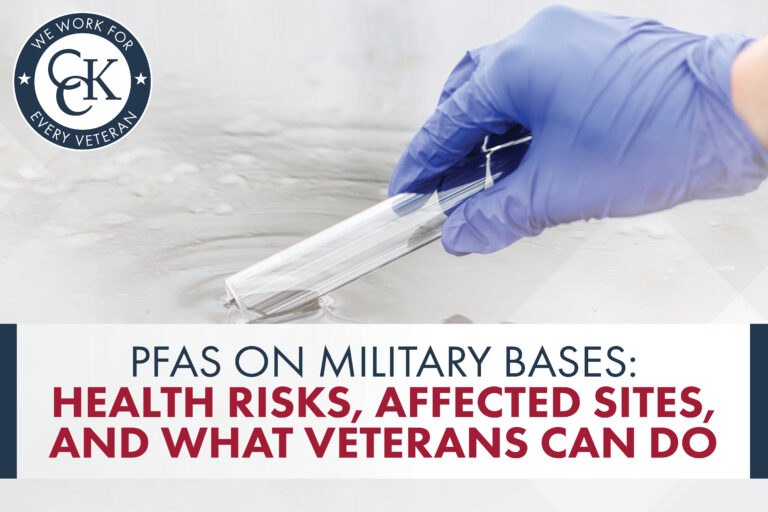PFAS on Military Bases: Health Risks, Affected Sites, and What Veterans Can Do

CCK Law: Our Vital Role in Veterans Law
Per- and polyfluoroalkyl substances, or “PFAS,” are a large group of toxic chemicals. They have been used since the 1940s in a wide range of products, from non-stick cookware to firefighting foam.
These chemicals don’t break down easily since they can resist water, oil, and heat. PFAS are widespread in modern life, and their use by the U.S. military has caused significant concern—especially for veterans and their families who lived or served on contaminated bases.
In this article, CCK Law will discuss:
- Where PFAS are found
- Why military bases have been affected by PFAS
- The health risks of exposure to PFAS
- What veterans can do if they’ve been exposed to these toxic chemicals
What Are PFAS and Why Are They Dangerous?
As mentioned, PFAS are toxic chemicals found in a variety of products. Since these chemicals are resistant to water, oil, and heat, they do not break down easily. As such, they are commonly referred to as “forever chemicals.”
Products that often contain PFAS include:
- Non-stick pans (Teflon)
- Food wrappers and containers
- Water-resistant jackets
- Carpeting and upholstery
- Firefighting foams (especially AFFF)
While useful, these chemicals are dangerous and pose health risks for humans. Since they do not break down easily, they remain in the environment for indefinite periods. This is due to PFAS containing carbon-fluorine bonds—some of the strongest bonds known. These chemicals—since they don’t break down—accumulate in soil, groundwater, and living organisms.
How Were PFAS Used on Military Bases?
Many U.S. military bases have used “aqueous film-forming foam” (AFFF) for decades. This firefighting foam is designed to quickly extinguish aircraft fuel fires. AFFF contains PFAS and repeated use during training exercises and emergencies has led to widespread contamination on many military bases.

This firefighting foam seeped into the surrounding soil and groundwater of these bases. Advanced testing methods were not available until the early 2000s, so these chemicals went largely undetected during routine environmental screening.
The U.S. military was able to detect these chemicals when it adopted “liquid chromatography tandem mass spectrometry.” This method of testing can identify water-soluble chemicals. Only then did the military fully understand the extent of “forever chemical” contamination on military bases.
Health Risks of PFAS Exposure
Research has identified several serious health conditions linked to PFAS exposure. These conditions apply to both military personnel and their families who lived or worked on affected installations.
For example, exposure can lead to several types of cancer and chronic illnesses, such as:
- Testicular cancer
- Kidney cancer
- Thyroid disease
- Liver damage
- Decreased fertility
- Developmental delays in children
- Immune system suppression
- And others
Individuals who drank or used contaminated water on base—especially over extended periods—are at the highest risk.
Military Bases with PFAS Contamination
According to the Environmental Working Group, 601 military bases have confirmed detection of PFAS contamination. A further 119 military sites have suspected contamination.
DAV cites EWG in their 2024 report on PFAS-contaminated water on military bases. This represents an increase of over 300 additional military sites since the Department of Defense (DoD) released a similar report in 2017.
Contamination of military bases with PFAS has occurred in all 50 states. Some military bases with known PFAS contamination include:
- Fort Wainwright (Fairbanks, Alaska)
- Naval Station Newport (Rhode Island)
- Robins Air Force Base (Houston County, Georgia)
- Norton Air Force Base (San Bernardino, California)
- USAF Academy (Colorado Springs, Colorado)
- And others.
The U.S. military has launched a nationwide PFAS cleanup effort, which includes:
- Investigating affected sites
- Shifting communities to alternate water sources
- Researching safer firefighting foam alternatives
In 2023, the EPA established enforceable drinking water limits of 4 parts per trillion (ppt) for several PFAS compounds, significantly tightening safety standards. These changes may accelerate cleanup efforts and legal accountability. Yet despite these cleanup efforts, contamination continues to pose an issue for veterans who served at these installations.
What Veterans Should Do If Exposed
Veterans and their loved ones who served on a base with confirmed PFAS contamination may be eligible for VA healthcare or disability compensation. However, it is important to note that medical conditions related to PFAS exposure are not considered presumptive by VA.
Nonetheless, if veterans think they may have been exposed to PFAS, they should:
- Check if their base is listed on the DoD’s PFAS installation list or the Environmental Working Group’s interactive map
- Document their time on base
- Talk to their doctor and request PFAS blood testing and screening for related conditions
Veterans can file a VA claim if applicable. However, those veterans who decide to file for VA disability compensation due to PFAS exposure must still establish the three elements of service connection to be eligible for benefits. These elements are (1) a current diagnosis, (2) an in-service event or exposure, and (3) a medical nexus linking the condition to service. Learn more in our article about establishing these three elements here.
Need Help Appealing a Denied VA Claim for PFAS Exposure?
PFAS contamination has impacted hundreds of military installations across the United States, exposing service members and their families to chemicals linked to serious health risks. Although the military and federal agencies have begun addressing this issue, cleanup will take years, and it is widely understood that many veterans may still be unaware of their exposure.
Despite increasing awareness of the issue, VA may deny your claim for benefits. If so, CCK Law may be able to help you with your appeal. Call us today at (800) 544-9144 for a free case evaluation with a member of our team.
About the Author
Share this Post
